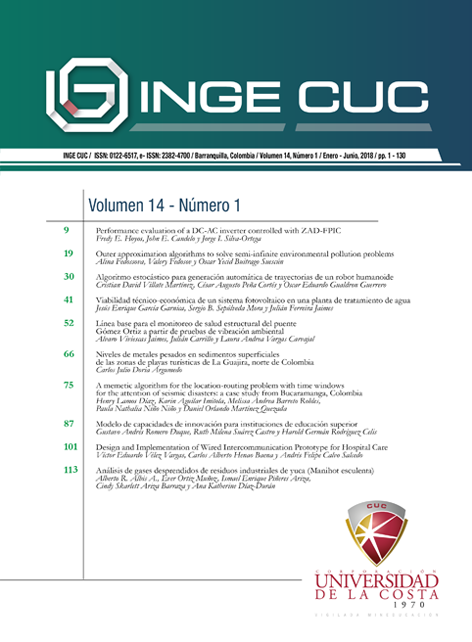Evaluation of the physical and mechanical properties of caña brava (Arundo donax) reinforced panels
DOI:
https://doi.org/10.17981/ingecuc.14.1.2018.06Keywords:
Composite materials, vegetal fibers, caña brava, physical properties, humidity, absorption, density, mechanical properties, static bending, fractureAbstract
Introduction: The use of composites made of vegetable origin materials has gained importance in some areas of engineering, mainly in civil construction.
Objective: The objective of this paper is to analyze the physical and mechanical behavior of panels made with caña brava fibers and vegetal resin.
Methodology: For the elaboration of the panels, the fibers were extracted using a mechanical crusher. The fibers were treated with a sodium hydroxide solution. The effect of the chemical treatment was evaluated by scanning electron microscopy. The roughness of the fibers was determined using the atomic force microscopy technique. For the manufacture of the composite, a compression method was used. The physical characterization of the panels was focused on the evaluation of the effective absorption, density, and percentage of swelling. To evaluate the mechanical behavior, static bending and mechanical fracture tests were performed. To evaluate the degradation of the material with the temperature, a thermogravimetric test was executed.
Results: From the results, it is possible to verify that panels made with caña brava fibers and vegetal resin can present an increase in their dimensional stability when compared to panels made with Guadua Angustifolia Kunth fibers and show higher values of strength and stiffness than panels elaborated with coconut and bamboo fibers.
Conclusions: Considering that caña brava is an invasive plant, its application as reinforcement of composite panels is a viable option to promote the development and application of new materials in civil construction.
Downloads
References
[2] J. Summerscales, N. Dissanayake, A. Virk y W. Hall, “A review of bast fibres and their composites. Part 1- Fibres as reinforcements. Composites Part A,” vol. 41, no. 10, pp. 1329-1335, 2010. Disponible en http://dx.doi.org/10.1016/j.compositesa.2010.06.001
[3] J. Summerscales, N. Dissanayake, A. Virk y W. Hall, “A review of bast fibres and their composites. Part 2- Composites. Composites Part A,” vol. 41, no. 10, pp. 1336-1344, 2010. Disponible en https://doi.org/10.1016/j.compositesa.2010.05.020
[4] S. Thomas, S. A. Paul, L. A. Pothan y B. Deepa, “Natural Fibres: Structure, Properties and Applications, Cellulose Fibers: Bio- and Nano-Polymer Composites,” en S. Kalia et al. (eds.), 2011, pp. 720.
[5] T. Lu, M. Jiang, Z. Jiang, D. Hui, Z. Wang y Z. Zhou, “Effect of surface modification of bamboo cellulose fibers on mechanical properties of cellulose/epoxy composites,” Compos Part B:Eng., vol. 51, pp. 28–34, 2013. Disponible en https://doi.org/10.1016/j.compositesb.2013.02.031
[6] L. Dányádi, J. Móczó y B. Pukánszky, “Effect of various surface modifications of wood flour on the properties of PP/wood composites,” Composite Part A: Appl. Sci. Manufact.,vol. 41, no. 2, pp. 199–206, 2010. Disponible en https://doi.org/10.1016/j.compositesa.2009.10.008
[7] G. Cantero, A. Arbeliaz, R. Liano-Ponte y I. Mondragon, “Effects of fibre treatment on wettability and mechanical behavior of flax/polypropylene composites,” Composite Science and Technology, vol. 63, no. 9, pp. 1247-1254, 2003. Disponible en https://doi.org/10.1016/S0266-3538(03)00094-0
[8] H. Alamri e I. M. Low, “Mechanical properties and water absorption behaviour of recycled cellulose fibre reinforced epoxy composites,” Polymer Testing, vol. 31, no. 5, pp. 620- 628, 2012. Disponible en https://doi.org/10.1016/j.polymertesting.2012.04.002
[9] X. Yanjun, A. S. H. Callum, X. Zefang, M. Holger, M. Carsten, “Silane coupling agents used for natural fiber/polymer composites: A review,” Composites Part A, vol. 41, no. 7, pp. 806-819, 2010. Disponible en https://doi.org/10.1016/j.compositesa.2010.03.005
[10] J. Rout, S. S. Tripathy, S. K. Nayak, M. Misra y A. K. Mohanty, “Scanning electron microscopy study of chemically modified coir fibers,” J, Appl, Polym, Sci., vol. 79, pp. 1169–1177, 2001. Disponible en https://doi.org/10.1002/1097-4628(20010214)79:7<1169::AID-APP30>3.0.CO;2-Q
[11] A. I. S. Brígida, V. M. A. Calado, L. R. B. Gonçalves y M. A. Z. Coelho, “Effect of chemical treatments on properties of green coconut fiber,” Carbohydr Polym, vol. 79, no. 4, pp. 832–838, 2010. Disponible en https://doi.org/10.1016/j.carbpol.2009.10.005
[12] M. Rokbi, H. Osmania, A. Imad y N. Benseddiq, “Effect of Chemical Treatment on Flexure Properties of Natural Fiber-reinforced Polyester Composite,” Procedia Eng, vol. 10, pp. 2092–2097, 2011. Disponible en https://doi.org/10.1016/j.proeng.2011.04.346
[13] M. N. Akhtara, A. B. Sulong, M. K. Fadzly Radzi, N. F. Ismail, M. R. Raza, N. Muhamad y M. A. Khan, “Influence of alkaline treatment and fiber loading on the physical and mechanical properties of kenaf/polypropylene composites for variety of applications,” Prog. Nat. Sci., vol. 26, no. 6, pp. 657–664, 2016. Disponible en https://doi.org/10.1016/j.pnsc.2016.12.004
[14] A. Orue, A. Jauregi, U. Unsuain, J. Labidi, A. Eceiza y A. Arbelaiz, “The effect of alkaline and silane treatments on mechanical properties and breakage of sisal fibers and poly(lactic acid)/sisal fiber composites,” Compos. Part A: Appl. Sci. Manufact., vol. 84, pp.186–195, 2016. Disponible en https://doi.org/10.1016/j.compositesa.2016.01.021
[15] V. Fiore, G. Di Bella y A. Valenza, “The effect of alkaline treatment on mechanical properties of kenaf fibers and their epoxy composites,” Compos Part B: Eng., vol. 68, pp. 14–21, 2015. Disponible en https://doi.org/10.1016/j.compositesb.2014.08.025
[16] M. J. John y R. D. Anandjiwala, “Recent developments in chemical modification and characterization of natural fiber-reinforced composites,” Polymer Composites, vol. 29, pp. 187-207, 2008. Disponible en https://doi.org/10.1002/pc.20461
[17] A. K. Mohanty, M. Misra y L. T. Drzal, “Surface modifications of natural fibers and performance of the resulting biocomposites: an overview,” Composite Interfaces, vol. 8, no. 5, pp. 313-343, 2001. Disponible en https://doi.org/10.1163/156855401753255422
[18] F. P. La Mantia y M. Morreale, “Green composites: A brief review,” Composites Part A, vol. 42, no. 6, pp. 579-588, 2001. Disponible en https://doi.org/10.1016/j.compositesa.2011.01.017
[19] Norma Técnica Colombiana - NTC 5301, Preservación y Secado del culmo de Guadua Angustifolia Kunth. Bogotá: Editorial Icontec, 2007
[20] A. H. Grigoriou y G. A. Ntalos, “The potential use of Ricinus communis L. (Castor) stalks as a lignocellulosic resource for particle boards,” Industrial Crops and Products, vol. 13, no. 3, pp. 209-218, 2001.
[21] M. L. Sanchez, L. Y. Morales y J. D. Caicedo, “Physical and mechanical properties of agglomerated panels made from bamboo fiber and vegetable resin,” Construction and Building Materials, vol. 156, no. 15, pp. 330-339, 2017.
[22] American Society for Testing and Materials, ASTM, D3800-16. Standard test method for density of highmodulus fibers. Philadelphia: ASTM, 2016.
[23] American Society for Testing and Materials, ASTM, D5229-14. Standard test method for moisture absorption properties and equilibrium conditioning of polymer matrix composite materials. Philadelphia: ASTM, 2014.
[24] American Society for Testing and Materials, ASTM, D2395-14. Standard Test Methods for Density and Specific Gravity (Relative Density) of Wood and Wood-Based Materials. Annual Book of ASTM Standards, 2014.
[25] American Society for Testing and Materials, ASTM, D 4442-16. Standard test method for direct moisture content measurement of wood and wood-based materials. Philadelphia: ASTM, 2016.
[26] H. Yoshihara, “Mode II fracture mechanics properties of solid wood measured by the three-point eccentric end-notched flexure test,” Engineering Fracture Mechanics, vol. 141, pp. 140–151, 2015. Disponible en: https://doi.org/10.1016/j.engfracmech.2015.05.028
[27] American Society for Testing and Materials, ASTM, D1037-12 Standard Test Methods for Evaluating Properties of Wood-Base Fiber and Particle Panel Materials. Philadelphia: ASTM, 2012.
[28] J. Fiorelli, F. A. R. Lahar, M. F. do Nascimento, H. Savastano y J. A. Rossignolo, “Painéis de partículas à base de bagaço de cana e resina de mamona – produção e propriedades,” Acta Scientiarum Technology, vol. 33, no. 4, pp. 401-406, 2011. Disponible en: DOI: 10.4025/actascitechnol.v33i4.96
[29] J. Fiorelli, D. Donizzetti, N. Barrero, H. Savastano, E. M. Agnolon y R. Johnson, “Particulate composite based on coconut fiber and castor oil polyurethane adhesive: An eco-efficient product,” Industrial Crops and Products, vol. 40, pp. 69–75, 2012. Disponible en: https://doi.org/10.1016/j.indcrop.2012.02.033
[30] H. S. Kim, H. S. Yang y H. J. Kim, “Thermogravimetric analysis of rice husk flour filled thermoplastic polymer composites,” Journal of Thermal Analysis and Calorimetry, vol. 76, no. 2, pp. 395-404, 2004.
Downloads
Published
How to Cite
Issue
Section
License
Published papers are the exclusive responsibility of their authors and do not necessary reflect the opinions of the editorial committee.
INGE CUC Journal respects the moral rights of its authors, whom must cede the editorial committee the patrimonial rights of the published material. In turn, the authors inform that the current work is unpublished and has not been previously published.
All articles are licensed under a Creative Commons Attribution-NonCommercial-NoDerivatives 4.0 International License.



 English
English
 Español (España)
Español (España)






















